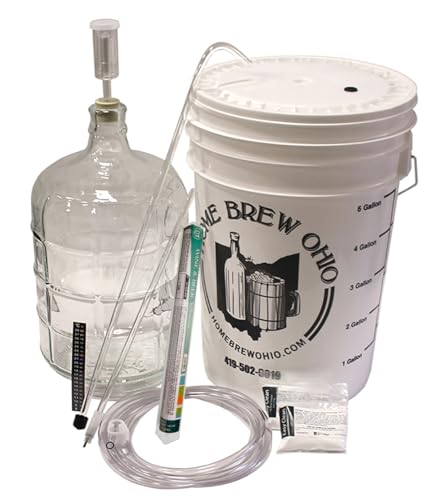I started my first 1 gallon batch with the craft-a-brew fruit wine making kit. I followed the directions to start the must in my fermentation bucket. Adding the sugar, tannin, pectic enzyme, and yeast nutes to some water, then adding the fruit in a mesh bag, per included directions. I had read elsewhere about adding the campden tablets to must and waiting 24 hours before adding yeast, to kill bacteria and wild yeast, so I added that too. My question is, did I mess it all up by adding the tablet after all the other chemicals in the must together? Is it a fixable mistake? I'm super new to this and am having a hard time finding a straight answer to my problem, thanks in advance.
You are using an out of date browser. It may not display this or other websites correctly.
You should upgrade or use an alternative browser.
You should upgrade or use an alternative browser.
Newbie confusion on chemical order, possible blunder.
- Thread starter Dylanger
- Start date

Help Support Winemaking Talk - Winemaking Forum:
This site may earn a commission from merchant affiliate
links, including eBay, Amazon, and others.
Welcome to WMT!
Your wine is fine. Nothing you added conflicts with anything else.
Follow the kit instructions -- they're designed for beginners with no experienced help to make a good wine on the first try.
Your wine is fine. Nothing you added conflicts with anything else.
Follow the kit instructions -- they're designed for beginners with no experienced help to make a good wine on the first try.
Thank you, that makes me feel much better.Welcome to WMT!
Your wine is fine. Nothing you added conflicts with anything else.
Follow the kit instructions -- they're designed for beginners with no experienced help to make a good wine on the first try.
I wrote a post last year, describing the contents of typical kits. You may want to read this, as it will explain at a high level what each ingredient is.
https://wine.bkfazekas.com/whats-in-a-wine-kit/
https://wine.bkfazekas.com/whats-in-a-wine-kit/
- Joined
- May 1, 2022
- Messages
- 171
- Reaction score
- 223
You should be fine.
Campden is usually added to stop wild yeast from getting started
as you did add some campden with your pitched yeast, a good portion of it may be affected and there may be a slow start to the fermentation. If in doubt, pitch more yeast. if it is already started then you will be ok.
Campden is usually added to stop wild yeast from getting started
as you did add some campden with your pitched yeast, a good portion of it may be affected and there may be a slow start to the fermentation. If in doubt, pitch more yeast. if it is already started then you will be ok.

$74.99 ($74.99 / Count)
Delirious Trembles Belgian Golden Strong Ale, Beer Making Extract Kit
Boomchugalug

$6.99 ($0.35 / Count)
Red Supply Solution Wine Grape 20 Seeds - Vitis Vinifera, Organic Fresh Seeds Non GMO, Indoor/Outdoor Seed Planting for Home Garden
ORGINBUD LLC

$169.50 ($169.50 / Count)
Wine Ingredient Kit - CRU SELECT Australia Style Chardonnay
Bridgeview Beer and Wine Supply

$14.80
$24.00
The Geography of Wine: How Landscapes, Cultures, Terroir, and the Weather Make a Good Drop
Amazon.com

$129.99 ($129.99 / Count)
$139.99 ($139.99 / Count)
Wild Grapes Premium Wine Equipment Starter Kit - Wine Making Supplies - All-in-One Wine Kit for Crafting Wine at Home, 6 Gallon Fermenter Makes Up To 30 Bottles
Wild Grapes™
Well i waited 24 hours before i pitched the yeast after the campden tablet, but it's been a week now, and per the directions, I've been opening and stirring the must daily, but I'm getting zero air lock activity. There's been a small amount of foam, and it smells like it's doing something, but Since I read your reply I thought maybe I should add a little yeast, so I added part of another pack 2 days ago, and still nothing on the air lock. Is it possible that part of the tablet is still in there killing the yeast, or is this "normal"?You should be fine.
Campden is usually added to stop wild yeast from getting started
as you did add some campden with your pitched yeast, a good portion of it may be affected and there may be a slow start to the fermentation. If in doubt, pitch more yeast. if it is already started then you will be ok.
Activity in the airlock tells you little of real usefulness. It may be fermentation, active degassing, changes in temperature/barometric pressure, or something else.Well i waited 24 hours before i pitched the yeast after the campden tablet, but it's been a week now, and per the directions, I've been opening and stirring the must daily, but I'm getting zero air lock activity. There's been a small amount of foam, and it smells like it's doing something, but Since I read your reply I thought maybe I should add a little yeast, so I added part of another pack 2 days ago, and still nothing on the air lock. Is it possible that part of the tablet is still in there killing the yeast, or is this "normal"?
What is your SG? The hydrometer tells you if you have activity, e.g., if the SG is dropping, the yeast is eating-n-excreting.
A normal dosage of sulfite will not harm commercial yeast. And not all batches foam heavily -- it depends on the yeast strain and the amount of solids in the must.
I checked the hydrometer, I don't remember the exact decimal numbers, but it started at 12% potential and is at 0 now. I suppose I was just overly worried about seeing the bubble activity. I appreciate all of the help, stuff like this seems so obvious after hearing someone say it lolActivity in the airlock tells you little of real usefulness. It may be fermentation, active degassing, changes in temperature/barometric pressure, or something else.
What is your SG? The hydrometer tells you if you have activity, e.g., if the SG is dropping, the yeast is eating-n-excreting.
A normal dosage of sulfite will not harm commercial yeast. And not all batches foam heavily -- it depends on the yeast strain and the amount of solids in the must.
Brix is a fine measurement when measuring a must pre-fermentation, but once it starts, use SG. It's finer grained and it's easier for folks to understand your situation and help. Always use 3 digits to the right of the decimal, as it avoids confusion. More than once we've had someone write "1.20" and it was unclear if they meant "1.020" or "1.002".I checked the hydrometer, I don't remember the exact decimal numbers, but it started at 12% potential and is at 0 now. I suppose I was just overly worried about seeing the bubble activity. I appreciate all of the help, stuff like this seems so obvious after hearing someone say it lol
Winemaking is actually very easy to do. Assuming all goes according to plan. When it doesn't, understanding the details of the physics, biology, and chemistry make understanding the situation and determining corrections far simpler. This doesn't mean you need a PhD in all three sciences, but remembering high school science is often enough.
Most things make sense when someone explains it in clear language.
Be prepared to keep learning -- there's always more to learn.
- Joined
- May 1, 2022
- Messages
- 171
- Reaction score
- 223
I have had wines slowly ferment and with little air lock activity
there are a few reasons I can surmise, but if the SG keeps lowering I know fermentation is going on
there are a few reasons I can surmise, but if the SG keeps lowering I know fermentation is going on
I know I haven't been on here in a bit, but just wanted to let everyone know the blackberry wine turned out great, might be my second favorite yet, behind the blueberry I made. Since, ive done batches of kiwi(pain to prepare but turned out good), and apple cinnamon mead(great while young, 2 bottles left aging) and a batch of strawberry I have going now. Thanks again for the help.
BernardSmith
Senior Member
Just to comment that as Winemaker81 suggested, activity in an airlock really tells you very little. In the first place, no activity can occur because there is a poor seal between the bung and the glass or between the bung and the airlock. A poor seal offers the carbon dioxide that the yeast produce an exit from the carboy that uses far less energy than bubbling through the liquid in the airlock. On the other hand, activity in the airlock after fermentation has begun may not indicate continued fermentation. Rather it may simply show that CO2 that has been saturating the liquid is being released and it is being released now, because of a change in ambient temperature or a change in air pressure or because points of nucleation are forcing the gas to collect and escape. The mosr reliable monitring tool you have is an hydrometer. Changes in the density of the liquid are what indicates the progression of the fermentation.
Making wine is really easy. One of the hardest parts is wading through all the opinions, incorrect information, and partial truths. It's customary to wait 24 hours from adding campden to pitching yeast. Customary meaning lots of people follow this practice and it's written in tons of recipes.having a hard time finding a straight answer to my problem
When everything is added to the must up front, it's not known what works and what doesn't. At the end of the day, wine is made. So, since wine is made, that's proof that there is no problem, right?
Well, not according to research, documentation, and many wine making professionals/chemists. The truth is, some of the additives totally inhibit others. It is known (at least known by some
Getting back to adding campden/SO2, it's best to add SO2 (1 campden tablet/gallon) at the beginning, and then wait at least 12 hours before adding pectic enzyme. As a matter of practice, I wait for another 12 or 24 hours after yeast pitch to add pectic enzyme.
This manual is a great resource for home winemakers and pro's alike. It's jammed packed full of information and helpful articles. For several short "pearls of wisdom" about the interaction of enzymes, check out the light blue graphic block at the bottom of page 111.
https://scottlab.com/content/files/documents/handbooks/scott labs 2024 winemaking handbook.pdf
Cheers,
Barry
Similar threads
- Replies
- 17
- Views
- 1K
- Replies
- 12
- Views
- 666
- Replies
- 28
- Views
- 3K















































